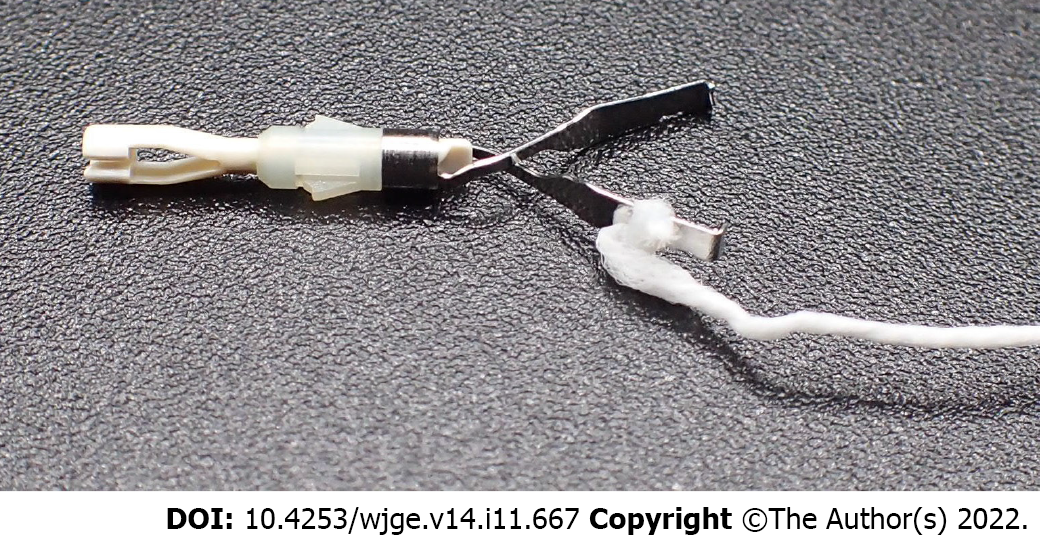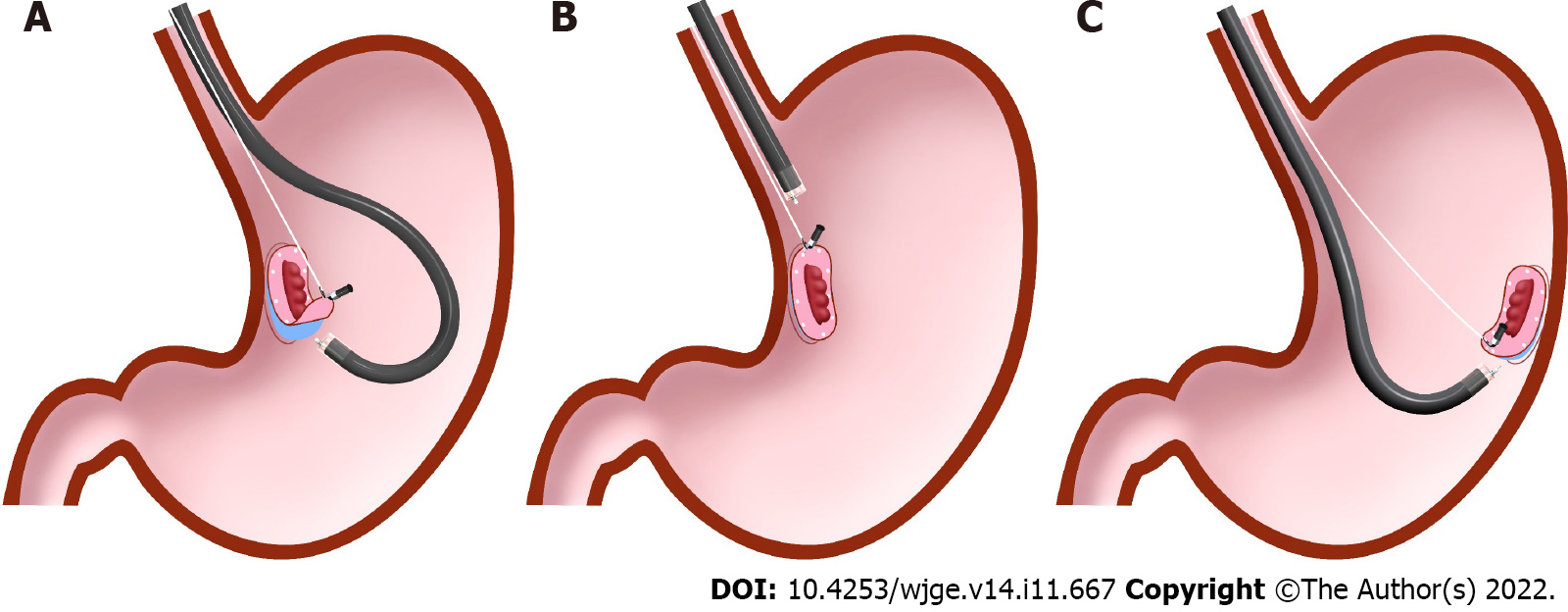Published online Nov 16, 2022. doi: 10.4253/wjge.v14.i11.667
Peer-review started: September 7, 2022
First decision: September 26, 2022
Revised: October 2, 2022
Accepted: October 14, 2022
Article in press: October 14, 2022
Published online: November 16, 2022
Processing time: 68 Days and 0.6 Hours
Various traction devices have been developed to secure a visual field and suf
Core Tip: Various traction devices have been developed for endoscopic submucosal dissection (ESD). However, few traction devices have been validated in large-scale studies thus far. The CONNECT-G trial was the first multicenter randomized controlled trial to compare conventional ESD with clip-with-line-assisted ESD for superficial gastric neoplasms. This study suggested that the effectiveness of traction devices in gastric ESD depends on the traction direction; in addition, the most optimal traction direction is vertical to the gastric wall.
- Citation: Nagata M. Optimal traction direction in traction-assisted gastric endoscopic submucosal dissection. World J Gastrointest Endosc 2022; 14(11): 667-671
- URL: https://www.wjgnet.com/1948-5190/full/v14/i11/667.htm
- DOI: https://dx.doi.org/10.4253/wjge.v14.i11.667
Endoscopic submucosal dissection (ESD) allows en bloc resection of superficial gastric neoplasms. However, gastric ESD is a challenging procedure. Surgeons can use their nondominant hand to generate traction for lesions while they resect using their dominant hand. Meanwhile, endoscopists cannot use their nondominant hand to generate traction because they cannot insert their hand into the stomach. Therefore, endoscopists occasionally cannot secure a visual field and sufficient tension at the dissection plane, resulting in a long ESD procedure time and a high perforation rate. Recently, many traction devices were reported to overcome these problems, but few large-scale studies investigated the effectiveness of traction devices in gastric ESD.
The CONNECT-G trial was the first multicenter randomized controlled trial to compare conventional ESD with traction-assisted ESD for the treatment of superficial gastric neoplasms[1]. In this study, clip-with-line (CWL) was used as a traction device (Figure 1), and its traction direction is restricted to the direction where the line is drawn[2,3]. The primary endpoint was the mean gastric ESD procedure time, which was 58.1 min in the conventional ESD group and 60.7 min in the CWL-assisted ESD (CWL-ESD) group, with no significant difference (P = 0.45). R0 resection was not statistically significant in both groups (96.8% vs 97.8%, P = 0.45). However, the perforation rate was significantly lower in the CWL-ESD group (0.3% vs 2.2%, P = 0.04), suggesting that CWL may have improved the field of vision and reduced blind submucosal dissection.
For lesions located at the greater curvature of the middle and upper third of the stomach, the CWL-ESD group had a significantly shorter gastric ESD procedure time than the conventional ESD group (57.2 min vs 104.1 min, P = 0.01). This part of the stomach is a challenging area for conventional ESD because it is basically a gravitational lower side, so a mucosal flap is difficult to deploy, and the visual field tends to deteriorate due to fluid retention. Nevertheless, CWL-ESD is particularly useful in this area. In this subgroup analysis, lesion location was divided into the anterior wall, posterior wall, lesser curvature, and greater curvature of the upper, middle, and lower third of the stomach. However, no significant difference was found in the procedure time of gastric ESD, except for lesions located at the greater curvature of the middle and upper third of the stomach.
The results of the CONNECT-G trail suggest that the effectiveness of CWL-ESD varies depending on the lesion location. Traction direction can be classified into five categories (Figure 2)[4]. Since CWL is a per-oral traction device, its traction direction is limited to the cardia and varies depending on the lesion location. Another consideration for the traction direction of CWL is the endoscopic position during submucosal dissection. Because of the large lumen of the stomach, there are two possible endoscopic positions: forward and retroflexed. Therefore, the traction direction also varies depending on the endoscopic position even if the lesion is in the same location. For example, for lesions located at the lesser curvature of the middle third of the stomach, CWL commonly provides a distal traction in re
The optimal traction direction in gastric ESD was not yet fully investigated. However, several studies indicated that a vertical traction is the optimal traction direction. The CONNECT-G trial suggests that CWL is effective for lesions located at the greater curvature of the upper and middle third of the stomach, and vertical traction is frequently performed in this area from an anatomical point of view (Figure 3C). CWL can essentially only provide vertical traction for lesions located at the greater cur
It is unclear whether other traction directions are effective in gastric ESD. Especially in distal traction, as the submucosal dissection progresses, the dissection plane falls toward a distal direction, which may be counterproductive because it may not provide an effective tension on the dissection plane. In CWL-ESD, a retroflexed endoscopic position occasionally results in a distal traction, and this position is common in gastric ESD. It is possible that a distal traction was provided for a relatively large number of cases in the CONNECT-G trial, and this could cause no significant difference in gastric ESD procedure time between conventional ESD and CWL-ESD in the total population of the CONNECT-G trial. However, the traction direction and endoscopic position were not reported, so this point should be further investigated.
In CWL-ESD, combined with the pulley method[8,9], the traction direction can be controlled, and vertical traction can be obtained. Therefore, the pulley method may improve the gastric ESD procedure time in CWL-ESD. However, since the pulley method in gastric ESD has been reported mainly in case series studies or ex-vivo studies, its feasibility and effectiveness should be further investigated.
Vertical traction may be the optimal traction direction in traction-assisted ESD for gastric neoplasms. Further studies are needed to investigate the effectiveness of other traction directions.
Provenance and peer review: Invited article; Externally peer reviewed.
Peer-review model: Single blind
Specialty type: Gastroenterology and hepatology
Country/Territory of origin: Japan
Peer-review report’s scientific quality classification
Grade A (Excellent): 0
Grade B (Very good): B, B
Grade C (Good): 0
Grade D (Fair): 0
Grade E (Poor): 0
P-Reviewer: Guo JT, China; Li S, China S-Editor: Liu JH L-Editor: A P-Editor: Liu JH
| 1. | Yoshida M, Takizawa K, Suzuki S, Koike Y, Nonaka S, Yamasaki Y, Minagawa T, Sato C, Takeuchi C, Watanabe K, Kanzaki H, Morimoto H, Yano T, Sudo K, Mori K, Gotoda T, Ono H; CONNECT-G Study Group. Conventional vs traction-assisted endoscopic submucosal dissection for gastric neoplasms: a multicenter, randomized controlled trial (with video). Gastrointest Endosc. 2018;87:1231-1240. [RCA] [PubMed] [DOI] [Full Text] [Cited by in Crossref: 123] [Cited by in RCA: 116] [Article Influence: 16.6] [Reference Citation Analysis (0)] |
| 2. | Oyama T, Kikuchi Y, Shimaya S, Tomori T, Hotta K, Miyata Y, Yamada S. Endoscopic mucosal resection using a hooking knife (hooking EMR) [in Japanese]. Stomach Intest. 2002;37:1151-1161. [DOI] [Full Text] |
| 3. | Oyama T. Counter traction makes endoscopic submucosal dissection easier. Clin Endosc. 2012;45:375-378. [RCA] [PubMed] [DOI] [Full Text] [Full Text (PDF)] [Cited by in Crossref: 101] [Cited by in RCA: 142] [Article Influence: 10.9] [Reference Citation Analysis (0)] |
| 4. | Nagata M. Advances in traction methods for endoscopic submucosal dissection: What is the best traction method and traction direction? World J Gastroenterol. 2022;28:1-22. [RCA] [PubMed] [DOI] [Full Text] [Full Text (PDF)] [Cited by in CrossRef: 37] [Cited by in RCA: 35] [Article Influence: 11.7] [Reference Citation Analysis (1)] |
| 5. | Nagata M. Modified attachment method using an S-O clip for gastric endoscopic submucosal dissection. VideoGIE. 2019;4:151-153. [RCA] [PubMed] [DOI] [Full Text] [Full Text (PDF)] [Cited by in Crossref: 10] [Cited by in RCA: 12] [Article Influence: 2.0] [Reference Citation Analysis (0)] |
| 6. | Nagata M. Internal traction method using a spring-and-loop with clip (S-O clip) allows countertraction in gastric endoscopic submucosal dissection. Surg Endosc. 2020;34:3722-3733. [RCA] [PubMed] [DOI] [Full Text] [Full Text (PDF)] [Cited by in Crossref: 27] [Cited by in RCA: 26] [Article Influence: 5.2] [Reference Citation Analysis (0)] |
| 7. | Nagata M, Fujikawa T, Munakata H. Comparing a conventional and a spring-and-loop with clip traction method of endoscopic submucosal dissection for superficial gastric neoplasms: a randomized controlled trial (with videos). Gastrointest Endosc. 2021;93:1097-1109. [RCA] [PubMed] [DOI] [Full Text] [Cited by in Crossref: 24] [Cited by in RCA: 26] [Article Influence: 6.5] [Reference Citation Analysis (0)] |
| 8. | Li CH, Chen PJ, Chu HC, Huang TY, Shih YL, Chang WK, Hsieh TY. Endoscopic submucosal dissection with the pulley method for early-stage gastric cancer (with video). Gastrointest Endosc. 2011;73:163-167. [RCA] [PubMed] [DOI] [Full Text] [Cited by in Crossref: 51] [Cited by in RCA: 59] [Article Influence: 4.2] [Reference Citation Analysis (0)] |
| 9. | Ge PS, Thompson CC, Jirapinyo P, Aihara H. Suture pulley countertraction method reduces procedure time and technical demand of endoscopic submucosal dissection among novice endoscopists learning endoscopic submucosal dissection: a prospective randomized ex vivo study. Gastrointest Endosc. 2019;89:177-184. [RCA] [PubMed] [DOI] [Full Text] [Cited by in Crossref: 22] [Cited by in RCA: 20] [Article Influence: 3.3] [Reference Citation Analysis (0)] |












